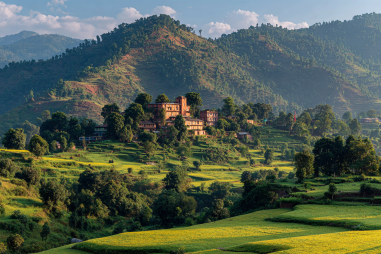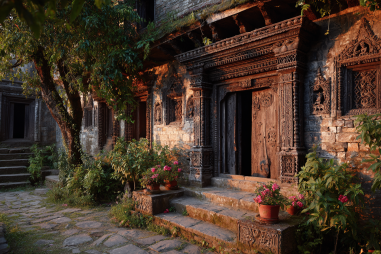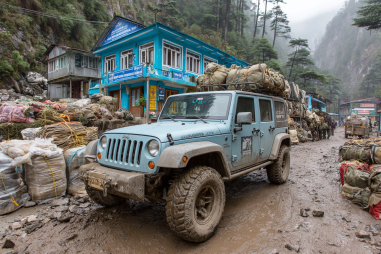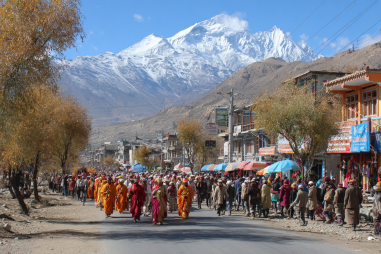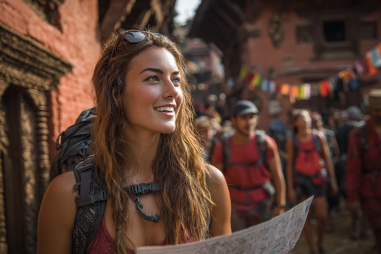Jomsom, nestled in the breathtaking Mustang region of Nepal, is a paradise for photographers. This charming town offers a unique blend of dramatic Himalayan landscapes, vibrant cultural scenes, and a peaceful atmosphere perfect for capturing stunning images. Whether you’re exploring snow-capped peaks, ancient monasteries, or lively local festivals, Jomsom’s photography spots will inspire your creativity and enrich your portfolio.
Iconic Landscapes and Viewpoints
Jomsom’s landscapes are nothing short of spectacular. The region boasts panoramic views of the Annapurna and Dhaulagiri mountain ranges, providing endless opportunities for majestic shots. Some of the most iconic photography spots include:
- Jharkot Village: Located a short drive from Jomsom, Jharkot offers stunning panoramic views of the Himalayas, especially the snow-capped peaks of Nilgiri and Dhaulagiri. Photographers can capture sprawling terraced fields against the backdrop of towering mountains.
- Kaligandaki River Gorge: One of the deepest river gorges in the world, the Kaligandaki Gorge creates dramatic contrasts between the river and the towering cliffs. Early morning shots here can capture mist rising along the water, creating a mystical effect.
- Tal Village: This ancient village provides rustic, traditional architecture surrounded by high-altitude landscapes — a perfect place for capturing the harmony between human settlement and nature.
- Jomsom Airport Viewpoint: Though small, this airport offers fascinating aviation photographs with mountains on all sides. The sight of small aircraft landing against rugged terrain is unique to this region.
The incredible diversity of these landscapes is a dream come true for photographers ready to capture nature’s rugged beauty.
Cultural and Festival Photography Opportunities
Jomsom is rich in cultural heritage, providing photographers with ample opportunities to document local life and traditions. The region is home to Tibetan Buddhist communities, whose monasteries and festivals add vibrant color and life to your shots.
Some highlights include:
- Thakali Museum and Village Life: Experience the traditional lifestyle of the Thakali people and capture intimate portraits of daily routines, traditional clothing, and craft-making.
- Lo-Manthang Festivals: Although located a bit further north, festivals in the walled city of Lo-Manthang, such as the Tiji Festival, offer mesmerizing cultural and ritual scenes worth the trek.
- Muktinath Monastery: Photographers can capture the spiritual essence of this revered site, where pilgrims gather amidst stunning mountain scenery.
Be sure to approach cultural photography with respect and sensitivity, always asking permission before photographing individuals or sacred ceremonies.
Best Times of Day for Natural Lighting
Lighting can make or break your photos, and Jomsom’s mountain environment offers fantastic natural light at certain times of day. For the best results, consider:
- Golden Hour (Sunrise and Sunset): The soft, warm light casts long shadows and enhances the textures of the rocky terrain. The sunrise over the Annapurna peaks is particularly spectacular, offering dramatic, colorful skies.
- Mid-Morning: When the sun is slightly higher, valley lighting is brighter yet still gentle, perfect for capturing village life and detailed landscapes.
- Blue Hour: Shortly after sunset, the cool tones of the blue hour create a mystical atmosphere over the mountains and river valleys, great for moody, atmospheric shots.
Overcast days can also be beneficial, softening contrasts and preventing harsh shadows, making them ideal for portraits and architectural photography.
Ethical Photography and Respect for Locals
When photographing in Jomsom, it’s essential to approach your work with ethics and respect for local people and culture. The communities here are friendly and welcoming, but some have cultural or religious reasons for limiting photography.
To ensure a responsible photography experience:
- Always ask for permission before photographing individuals, especially children and monks.
- Be mindful of sacred places and avoid taking photos during rituals unless allowed.
- Respect personal space and avoid using flash photography in sensitive areas.
- Support local businesses and photographers to contribute to the community’s wellbeing.
By following these guidelines, you’ll capture genuine moments while fostering mutual respect and kindness.
Equipment Recommendations for Mountain Photography
To make the most of your photography adventure in Jomsom, packing the right gear is crucial. The varying landscape and weather conditions require versatile equipment:
- Camera: A DSLR or mirrorless camera with manual settings is ideal for flexibility and quality.
- Lenses: Bring a wide-angle lens (14-24mm or 16-35mm) for landscapes, a mid-range zoom (24-70mm) for versatile shots, and a telephoto lens (70-200mm) for distant details like peaks or wildlife.
- Tripod: Essential for stable shots during low-light conditions such as sunrise, sunset, and long exposures.
- Filters: Polarizing filters help reduce glare and enhance sky contrast, while neutral density filters allow for creative long exposures.
- Protective gear: Waterproof covers and lens cleaners help protect equipment from dust and changing weather.
Additionally, consider extra batteries and memory cards, as cold temperatures can drain batteries faster.
Tips for Drone Photography in the Area
Drone photography opens new creative possibilities in Jomsom, providing sweeping aerial views of the Himalayas and river valleys. However, flying drones here requires extra caution and respect:
- Check local regulations before flying. Some regions in Nepal have restrictions, especially near airports and sacred sites.
- Avoid flying near crowds, religious festivals, or wildlife, to prevent disturbance.
- Fly drones only during daylight hours with good weather conditions to maintain control and ensure safety.
- Respect locals’ privacy—avoid capturing images of people without consent.
- Invest in a drone with a reliable GPS system and return-home feature, crucial in mountainous terrain.
When used responsibly, drones can reveal fantastic perspectives that elevate your Himalayan photography portfolio.
Leaving with Lasting Memories
Photographing Jomsom is more than just taking pictures—it’s about connecting with an incredible environment and culture through your lens. Whether you capture sunrise over Annapurna, intimate portraits of local life, or sweeping vistas from a remote monastery, the images you create will tell stories of adventure, serenity, and timeless beauty. Remember to shoot with respect, pack wisely, and embrace the magic of the Himalayas. Your journey through Jomsom’s photography spots promises unforgettable memories and inspiring images that you’ll treasure long after you’ve returned home.


